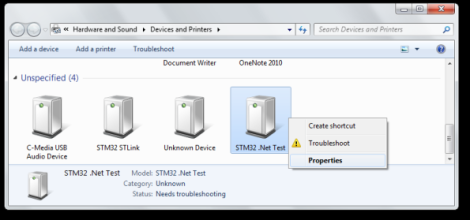When it comes to cryptocurrency security, what’s the best way to secure the private key? Obviously, the correct answer is to write it on a sticky note and put it on the bezel of your monitor; nobody’ll ever think of looking there. But, if you’re slightly more paranoid, and you have access to a Falcon 9, you might just choose to send it to the Moon. That’s what is supposed to happen in a few months’ time, as private firm Lunar Outpost’s MAPP, or Mobile Autonomous Prospecting Platform, heads to the Moon. The goal is to etch the private key of a wallet, cheekily named “Nakamoto_1,” on the rover and fund it with 62 Bitcoins, worth about $1.5 million now. The wallet will be funded by an NFT sale of space-themed electronic art, because apparently the project didn’t have enough Web3.0 buzzwords yet. So whoever visits the lunar rover first gets to claim the contents of the wallet, whatever they happen to be worth at the time. Of course, it doesn’t have to be a human who visits.
Visual Studio5 Articles
Hackaday Links: Remember, Remember
Buckle up, buttercup because this is the last weekly Hackaday Links post you’re getting for two weeks. Why? We have a thing next weekend. The Hackaday Superconference is November 11th and 12th (and also the 10th, because there’s a pre-game party), and it’s going to be the best hardware con you’ve ever seen. Don’t have a ticket? Too bad! But we’ll have something for our Internet denizens too.
So, you’re not going to the Hackaday Supercon but you’d like to hang out with like-minded people? GOOD NEWS! Barnes & Noble is having their third annual Mini Maker Faire on November 11th and 12th. Which Barnes & Noble? A lot of them. Our reports tell us this tends to be geared more towards the younger kids, but there are some cool people doing demonstrations. Worst case scenario? You can pick up a copy of 2600.
PoC || GTFO 0x16 is out! Pastor Laphroaig Races The Runtime Relinker And Other True Tales Of Cleverness And Craft! This PDF is a Shell Script That Runs a Python Webserver That Serves a Scala-Based JavaScript Compiler With an HTML5 Hex Viewer; or, Reverse Engineer Your Own Damn Polyglot.
In, ‘Oh, wow, this is going to be stupid’ news, I received an interesting product announcement this week. It’s a USB C power bank with an integrated hand warmer. Just think: you can recharge your phone on the go, warm your hands in the dead of winter, and hope your random battery pack from China doesn’t explode in your pocket. I’m not linking to this because it’s that dumb.
You can now cross-compile ARM with GCC in Visual Studio.
The iPhone X is out, and that means two things. There are far too many YouTube videos of people waiting in line for a phone (and not the good kind), and iFixit did a teardown. This thing is glorious. There are two batteries and a crazy double-milled PCB stack with strange and weird mezzanine connectors. The main board for the iPhone X is completely unrepairable, but it’s a work of engineering art. No word yet on reusing the mini-Kinect in the iPhone X.
Speaking of irreparable computers, the Commodore 64 is not. [Drygol] recently came across a C64 that was apparently the engine controller for a monster truck found on the bottom of the ocean. This thing was trashed, filled with rust and corrosion, and the power button just fell off. Prior to cleaning, [Drygol] soldered a new power button, bowered it up, and it worked. The crappiest C64 was repairable. A bit of cleaning, painting the case, and the installation of an SD2IEC brought this computer back to life, ready for another thirty years of retrogaming and BASIC.
The Zynq from Xilinx is one of the most interesting parts in recent memory. It’s a dual-core ARM Cortex A9 combined with an FPGA with a little more than a million reconfigurable gates. It’s been turned into a synth, a quadcopter, all of British radio, and it’s a Pynq dev board. Now there’s a new part in the Zynq family, an RFSoC that combines the general ARM/FPGA format with some RF wizardry. It’s designed for 5G wireless and radar (!), and one of those parts we can’t wait to see in use.
Do you keep blowing stuff up when attaching a USB to UART adapter to a board? Never fear, because here’s one with galvanic isolation. This is done with a neat digital isolator from Maxim
Massive Microsoft Machinations For Makers
If you’re not stuck in the tech news filter bubble, you may not have heard the Microsoft Build Developers Conference is going on right now. Among the topics covered in the keynotes are a new Office API and a goal to have Windows 10 running on a Billion devices in a few years.
There are, however, some interesting things coming out of the Build conference. Windows 10 is designed for hackers, with everything from virtual Arduino shields running on phones, Windows 10 running on Raspberry Pis, and Visual Code Studio running on OS X and Linux.
This is not the first time in recent memory Microsoft has courted the maker market. Microsoft begrudgingly supported the hardware dev scene with the PC version of the Microsoft Kinect, and a year or two ago, Microsoft rolled out drivers for 3D printers that were much more capable than the usual serial interface (read: the ability for printer manufacturers to add DRM). To the true, tie-die wearing, rollerblade-skating, acoustic coupler-sporting, Superman III-watching hackers out there, these efforts appear laughable – the product of managers completely out of touch with their audience.
Depending on your perspective, the new releases for the Arduino, Raspberry Pi, and other ‘maker-themed’ hardware could go one way or the other.
As far as educational efforts go, the Windows Remote Arduino and Windows Virtual Shields for Arduino are especially interesting. Instead of filling a computer lab up with dozens of Arduinos and the related shields, the WVSA uses the sensors on a Windows 10 smartphone with an Arduino. Windows Remote Arduino allows makers to control an Arduino not through the standard USB port, but a Bluetooth module.
If Arduinos aren’t your thing, the Windows 10 IoT preview for the Raspberry Pi 2 and Minnowboard Max is out now. The Win10 IoT distribution does not yet have working WiFi or Bluetooth, making it the single most useless operating system for Internet of Things devices. It was, however, released at the Build conference.
Also announced was a partnership with a fabulous hardware project hosting site, Hackster.io. Microsoft and Hackster.io will be collaborating with hackathons and other events focused on Windows technology. I get why they wouldn’t want another, vastly more popular project hosting site doing this, but I’m a little confused at why Instructables wasn’t the top Microsoft pick.
As always, you may express your infinite derision in the comments below. Spelling Microsoft with a dollar sign will result in a ban.
.NET For The STM32 F4 Discovery Board

Here’s a technique that will let you use the .NET framework on an STM32 Discovery board. [Singular Engineer] was happy to learn that the .NET Micro Framework had been ported for STM32 chips. It’s doesn’t look like the port has hit a stable version yet, but these instructions will be enough to get you up and running. This lets you use managed code in the C# language to program an embedded device: the STM32 F4 Discovery board.
After flashing a new bootloader to the board a driver needs to be added for Windows to communicate with it. Above you can see that the board will enumerate as ‘STM32 .Net Test’. Once the driver is installed the rest of the firmware can be loaded on the board using a GUI supplied with the NETMF for STM32 package. That takes care of prepping the hardware, the rest is a painless process of configuring Visual Studio to use the board as a target. The ‘Hello World’ application then uses C# to blink an LED.
Kinect For Windows Resources

Despite having been out for nearly two months, the world has yet to see a decent guide to the Kinect for Windows. While the Xbox and Windows versions of the Kinect use basically the same hardware, there are subtle but important differences. Thanks to [Matthew Leone] and his awesome summary of developer resources, getting your Kinect project up and running is now a lot easier.
After getting the SDK from the Microsoft Kinect for Windows site, you might want to check out the Microsoft Programming Guide. The Windows Kinect can only be used with Visual Studio, but with that inflexibility comes a few added features. Both versions of the Kinect have a microphone array that allows for determining the direction of a sound source. The Open Source driver has very little support for audio input, but the official Microsoft version has all the APIs for audio capture, source localization, and speech recognition ready to go.
At $250, the Kinect for Windows is a fairly hefty investment. A used Xbox Kinect can be had for around $80, so we’re pretty certain the hacker community is going to steer itself away from the Windows version. Still, if you’re ever paid to develop something for the Kinect you might want the friendly APIs and features not found in the XBox version.












